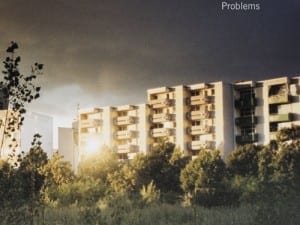That short walk from Bradford Interchange to Impressions Gallery takes the visitor along a stretch of streets lined with 1960s, somewhat brutalist, “typewriter” edifices interspersed with, at points, decaying testaments to Victorian, industrial, textile zeal and innovation. While those decaying columns and arches seem to foreshadow one of the themes at play in Roads to Wigan Pier – the effects of de-industrialisation – the almost clinical sterility of that 1960s architectural brutality seems to augur another: the alienating effects of impersonal domestic dwellings. An island of positive hope emerges at the end of this journey: Centenary Square. Here, we find the excellent Bradford Town Hall facing a terrace of bars and eateries with outside seating complete with parasols to satisfy the aspiring civility of our contemporary quasi-Mediterranean sensibilities. Housed above a portion of this terrace is the gallery. In November 1972, Impressions Gallery began as an above-shop room in the City of York. It moved to Bradford in 2007. To mark the gallery’s 40th year, as a vital promoter of photography in Britain and beyond, a highly potent and thought-provoking exhibition from the archive is currently being presented. First shown in October 1984, Roads to Wigan Pier consists of the work of six then newly graduated students. They took Orwell’s seminal work, The Road to Wigan Pier as their starting point and documented social aspects of the North of England.
Huw Davies’ work sought to look at the industries that had developed along the Leeds-Liverpool Canal . The visitor is presented with a series of portaits intended to reflect the alienation of the subjects resulting from the demise of those industries. The sense of alienation is detectable visually in these stark, black and white portaits in the apparent physical isolation of the subjects. Generally, the images of these people are captured within working context. Boilerman, Jimmy Cowell, is positioned in front of a very large boiler, presumably that which provided the heating for the Graham and Brown Wallpaper Printers, Blackburn, of his caption. Mr. Cowell, as with all subjects captured, looks to the camera and in his case he is smiling. The gaze of the subjects direct to camera enables the viewer to engage with their humanity. For viewers who do not or did not associate with members of the traditional working class because of feelings related to the rigidity of social class stratification, the sense of humanity, captured well by Davies, speaks to the heart. This sense coupled with the personal working histories of the subjects detailed in the captions, which often include quotes from the individuals pictured, compounds empathetically the sense of alienation with a personal touch. Perhaps the most interesting portrait-quote coupling is the picture of Welder and General Engineer, Nigel Callahan. A young man, he stands amongst scrap on a workshop floor holding a welder’s mask. He is quoted as saying that he prefers now (then) to work for a smaller firm because “You’re a person, not a number”. This might indicate, for Nigel, a positive slant on the contemporaneous, forced move socially and economcially from a collectivist, duty-bound attitude to a more individualistic one. The irony, if we were to read this into it, is that a consequence of having to move to a smaller firm was fewer colleagues, therefore, potentially, fewer acquaintcances and friends.
Graham Hall captured images of both striking and working miners in Nottinghamshire and Wigan. In doing so, he recorded working practices which had remained unchanged since Orwell’s observations. Again, owing to the black and white employed, as with all images in this exhibition, there is very strong sense of seriousness and starkness here. This reinforces a severe impression of the tough working conditions shown. In the case of the striking miners captured, it is possible to sense anger and frustration: in one of these images it appears that a man is squaring up to camera. Badges on his jacket indicate politicisation. This is a bold, personal reminder of the effects of detached, dispassionate, sweeping economic change. An image that imparts a strong sense of the toughness of the working conditions involves miners within the pit wearing helmets with illuminated lamps. The lamps illuminate only their heads; the rest is darkness.
John Kemp presented images of Wigan, Burnley, Rochdale and Bradford as examples of “northern wasteland”. Here, environmental poverty is the concern as influenced by the then new, though impersonal, housing estates. These images are very strong because they are examples of the oppressive and surrealistic blandness and ugliness with which people have to live. Although the domestic facilities were a great improvement on those recorded by Orwell, there is a great sense of the frustrating clinical numbness that comes with such imposed, impersonal regularity. In one image the viewer is presented with a hotch-potch of overlapping, impersonal linear regularities: high-rise flats, lamp posts, sign posts, road kerbs, road lines and power lines. Such an image would be virtually unimaginable as an isolated contrivance. Although fairly intricate, the heart sinks at this impersonal, artificial, synthetic mess.
Tim Smith’s concern was local industry and housing in Sheffield. High rises feature heavily here as examples of the legacy of misguided thinking with most residents unemployed because of changes to the steel industry. A particularly striking image features the large plaque commemorating the opening of Park Hill Flats. The dedication to “The Rt. Hon. Hugh Gaitskill C.B.E., M.P.” – the politician who opened the block – is obscured by a riot of graffiti; an innocuous testament to the boredom and frustration of unemployment. An arresting image centres around a female worker inspecting hacksaw blades. The stark contrasts of the image colouring reinforces the bleakness of the grimy working conditions shown, thus compounding the message that, owing to economic gender inequality, female breadwinners mean poorer households.
Julian Jermain concentrated on Wigan and Rochdale, recording the deprivation that resulted from automation on labour-intensive industries. One image, striking for the complexity and intricacy of the geometrical regularity, centres around a solitary male worker surrounded by computerised machinery. There is distance between the camera and the man featured, and he is dwarfed by the technology. Here, a strong sense of the worker’s isolation is conveyed. This alienation is one side of the coin of the automation featured by Jermain. The other is evinced in the images of domestic deprivation. One that is arresting, alarming and quite upsetting shows three very young children (one is a baby) sharing a single child’s bed. The carpet is dirty and there are stains on the wall.Of course, the children are not bothered by this; such is indicated by their facial expressions. This detail imbues the image with greater pathos.
Russell Boyce concentrated generally on Hull’s fishing dockland and its community. In particular he looked at a one-parent family. In this way he used Orwell’s example of quoting the struggle of an individual as a call for social change. In one image we observe that the lavatory is in the back yard. In another we are presented with a blunt and oppressive corregated fence in front of some wasteland. The photographs that concentrate on the one-parent family centre around the mother. In one we view her working in a very worn out kitchen; the blended darkness of the resolution heightens the bleakness of her situation. One image shows only the shoes on her crossed feet; the soles of the shoes are worn out and there are holes appearing in the toes. In another shot she is seated in an armchair smoking with the television switched on; she is exhausted. It is an interesting thought that eight years later, women in her position would be targeted as the scapegoats for the frustrations of those also oppressed by the effects of the recession under the Conservative government. It is an interesting feature of our society, with its predominantly right-wing press, that governments in tandem with that press are able to prevent the union of groups of individuals with common economic interests by dividing and ruling. The use of this exhibition to mark the fortieth birthday of the gallery is therefore timely. An exhibition such as this might inspire new photographers to capture images of the sick, disabled and unemployed. These are some of the sentiments invoked by Roads to Wigan Pier.
Roads to Wigan Pier, running until 5 January 2013, Impressions Gallery, Centenary Square, Bradford, BD1 1SD
Daniel Potts
Credits
1. I’m so bloody bored, Russel Boyce, courtesy of Impressions Gallery
2. Tim Smith, courtesy of Impressions Gallery
3. J.G. Collins, Huw Davies, courtesy of Impressions Gallery
4. Tina’s House, Russell Boyce, courtesy of Impressions Gallery
5. Waren Wright, Huw Davies, courtesy of Impressions Gallery




